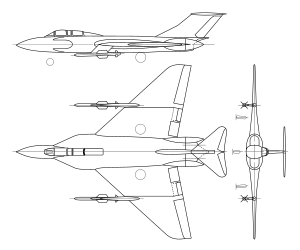| P.370/P.376 | |
|---|---|

| |
| Role | Interceptor aircraft |
| National origin | United Kingdom |
| Manufacturer | Gloster Aircraft |
| Status | Cancelled, 1956 |
| Primary user | Royal Air Force (intended) |
| Developed from | Gloster Javelin |
The thin-wing Javelin refers to a series of design studies for an improved supersonic-capable version of the Gloster Javelin aircraft. Depending on the source, it is also known as F.153D, after its Air Ministry issued Operational Requirement, or the Super Javelin in some Gloster documents.
Gloster Aircraft had been studying a variety of updates and variations of the Javelin from before the first production model flew in 1953. These generated enough interest for the Air Ministry to ask for a version switching the Javelin's Armstrong Siddeley Sapphire engines for the more powerful Bristol Olympus. In September 1954, Gloster offered three minor variations on this concept, P.370 through P.372. In November 1954, the Air Ministry offered an official development contract for this "Thin Wing Gloster All-Weather Fighter", starting the construction of prototypes of the P.371 version which was expected to reach just over Mach 1.
During the design period, Bristol Siddeley began development of a major update to the Olympus. Moving to these engines offered much better performance. The ultimate version was the P.376, which featured a thinner wing and area ruled fuselage to lower wave drag, almost double the engine power of the original Javelin, and new intakes to improve airflow to the engines at supersonic speeds. These changes were expected to allow the design to reach Mach 1.6 at altitudes up to 60,000 feet (18 km) while carrying two of the very large Red Dean missiles.
The first of two P.371 prototypes was under construction when the project was cancelled in the spring of 1956 in favour of purchasing the Canadian Avro Arrow. The Arrow was expected to be available in 1959, two years before the P.376, and was also significantly faster. The Arrow purchase was also cancelled due to delays, and the money was redirected towards the Operational Requirement F.155 designs. F.155 was also cancelled the next year in the aftermath of the release of the 1957 Defence White Paper.